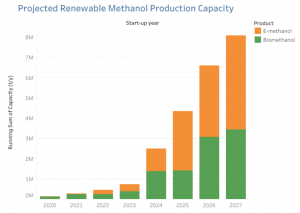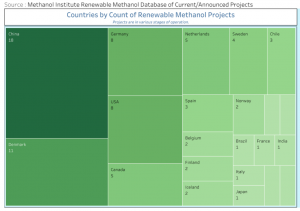
Methanol Institute Sees Renewable Methanol Production Growth
Infographics, using the collected data, have helped to contextualize the global distribution of renewable methanol projects, and projected production capacity expansion over the coming years. The interactive map provides data for each announced project including company name, location, planned production capacity, and anticipated year for the start of production.
Methanol is an essential chemical building block and emerging energy resource. Methanol is synthesized using a mixture of hydrogen, carbon dioxide, and carbon monoxide. These elements can be derived from a variety of feedstocks and processes, with conventional methanol produced from natural gas or coal. Renewable methanol is a low carbon and net carbon neutral liquid chemical and fuel produced from sustainable biomass, often called bio-methanol, or from captured carbon dioxide and hydrogen produced from renewable electricity, referred to as e-methanol.
Renewable methanol significantly reduces greenhouse gas intensity and contributes to the energy transition in end-user markets particularly in hard-to-abate sectors. As a building block for many downstream chemicals, low-carbon methanol facilitates the production of green chemicals. Sustainably produced methanol is also being utilized as an alternative drop-in fuel in shipping, road transport, and power generation to lower overall emissions and impact on the environment.
“With 80 renewable methanol projects already announced, we are seeing clear signs of an incoming wave of bio-methanol and e-methanol production,” said Methanol Institute CEO Gregory Dolan. “Given the growing interest in renewable methanol, we developed new tools to track e-methanol and bio-methanol projects that have been announced around the world. With this global interactive map now on our website and projected production charts, industry stakeholders and policymakers have a clearer picture of the growing trendline we see for renewable methanol.”
In addition to the growing number of renewable methanol projects, there is clear evidence that the scale of production for bio-methanol and e-methanol facilities is ramping up. With ongoing advancements in technology and increased government support, the capacity of individual renewable plants is expected to rise from 5,000-10,000 metric tons of methanol per year to 50,000-250,000 metric tons per year or more over the next five years.
Users can now see the infographics on MI'S website: HERE
Lawrence Navin
Methanol Institute
+1 703-248-3636
email us here
EIN Presswire does not exercise editorial control over third-party content provided, uploaded, published, or distributed by users of EIN Presswire. We are a distributor, not a publisher, of 3rd party content. Such content may contain the views, opinions, statements, offers, and other material of the respective users, suppliers, participants, or authors.




